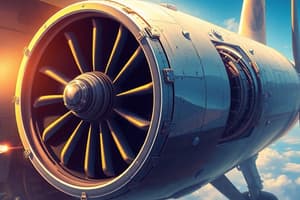Podcast
Questions and Answers
What is required for RNAV Standard Instrument Departures (SIDs)?
What is required for RNAV Standard Instrument Departures (SIDs)?
- VOR navigation only
- RNAV 1 performance (correct)
- Basic radar capability
- RNAV 2 performance
What should be filed in the remarks of a flight plan if a pilot chooses not to use Standard Instrument Departures (SIDs)?
What should be filed in the remarks of a flight plan if a pilot chooses not to use Standard Instrument Departures (SIDs)?
- SIDs Accepted
- Request No SIDs
- Avoid SIDs
- No SIDs (correct)
What can be stated if a pilot decides not to use Standard Terminal Arrivals (STAR)?
What can be stated if a pilot decides not to use Standard Terminal Arrivals (STAR)?
- No STARs (correct)
- STARs chosen
- Avoid all STARs
- Exempt from STARs
What is the minimum weather condition requirement for listing an alternate airport?
What is the minimum weather condition requirement for listing an alternate airport?
What characterizes the routes that connect en route fixes to the basic STAR procedures?
What characterizes the routes that connect en route fixes to the basic STAR procedures?
What does MDA/H stand for in aviation terminology?
What does MDA/H stand for in aviation terminology?
What is the primary purpose of MEA?
What is the primary purpose of MEA?
Which altitude provides obstacle clearance within 22 NM of a NAVAID?
Which altitude provides obstacle clearance within 22 NM of a NAVAID?
What does the term RCA refer to in aviation?
What does the term RCA refer to in aviation?
What minimum altitude should pilots maintain to ensure obstacle clearance over mountainous terrain?
What minimum altitude should pilots maintain to ensure obstacle clearance over mountainous terrain?
What type of flight plan is exempt from certain reporting requirements?
What type of flight plan is exempt from certain reporting requirements?
Which altitude ensures obstacle clearance within 4 NM of a course?
Which altitude ensures obstacle clearance within 4 NM of a course?
What is a requirement under IFR takeoff minimums for part 91 operations?
What is a requirement under IFR takeoff minimums for part 91 operations?
What equipment must be dealt with by either removing or placarding it when flying without a special flight permit?
What equipment must be dealt with by either removing or placarding it when flying without a special flight permit?
What is one of the limitations of Standard VOR service?
What is one of the limitations of Standard VOR service?
When must a VOR receiver be checked?
When must a VOR receiver be checked?
Which altitude represents the ceiling for Standard VOR service?
Which altitude represents the ceiling for Standard VOR service?
What is a potential issue when a VOR is used incorrectly?
What is a potential issue when a VOR is used incorrectly?
What is the minimum required cross-country PIC time for an airplane instrument rating?
What is the minimum required cross-country PIC time for an airplane instrument rating?
How many hours of actual or simulated instrument time must be logged for an airplane instrument rating?
How many hours of actual or simulated instrument time must be logged for an airplane instrument rating?
What is the required amount of instrument time that must be completed with a Certified Flight Instructor Instrument (CFII)?
What is the required amount of instrument time that must be completed with a Certified Flight Instructor Instrument (CFII)?
Which of the following is NOT a requirement for logging instrument time?
Which of the following is NOT a requirement for logging instrument time?
What is required for an instrument PIC recency of experience in the last 6 months?
What is required for an instrument PIC recency of experience in the last 6 months?
Which personal document is NOT required for flight operations?
Which personal document is NOT required for flight operations?
What type of license is required for flights outside the U.S.?
What type of license is required for flights outside the U.S.?
How many different kinds of approaches must be included in the logged instrument time?
How many different kinds of approaches must be included in the logged instrument time?
What is the minimum visibility requirement for a standard instrument approach?
What is the minimum visibility requirement for a standard instrument approach?
Which of the following visual references is NOT valid for the intended runway during an approach?
Which of the following visual references is NOT valid for the intended runway during an approach?
For a CAT I approach, what is the defined radius for circling maneuver in knots?
For a CAT I approach, what is the defined radius for circling maneuver in knots?
Which of the following describes the Visual Descent Point (VDP)?
Which of the following describes the Visual Descent Point (VDP)?
What must pilots do if they are not equipped to identify the Visual Descent Point (VDP)?
What must pilots do if they are not equipped to identify the Visual Descent Point (VDP)?
Which approach type does NOT provide vertical course guidance?
Which approach type does NOT provide vertical course guidance?
What is a significant feature of an APV approach?
What is a significant feature of an APV approach?
Which instrument approach type is identified as not aligned with the runway?
Which instrument approach type is identified as not aligned with the runway?
Flashcards are hidden until you start studying
Study Notes
Minimum Aeronautical Experience for Instrument Rating
- 50 hours of cross-country pilot-in-command (PIC) time required.
- Logging of instrument time includes 10 hours specifically in airplanes.
- 40 hours of actual or simulated instrument time needed, with 15 hours under a Certified Flight Instructor - Instrument (CFII).
- Includes at least one cross-country flight of 250 nautical miles, following airways or ATC routing.
Instrument Flight Conditions
- Must conduct flight operations solely by reference to instruments under actual or simulated instrument conditions.
- Required to complete three different types of approaches using various navigation systems.
- A filed IFR flight plan is necessary for the above operations.
Instrument Pilot Recent Experience Requirements
- At least 3 hours of instrument flight time in the last 2 calendar months before the practical test.
- Within the last 6 calendar months, pilots must log six instrument approaches, holding procedures, and interception & tracking courses via electronic navigation systems.
Personal Documents Required for Flight
- Pilot certificate and valid medical certificate.
- Authorized photo ID, such as a passport or driver’s license.
- Restricted radiotelephone operator license needed for flights outside the U.S.
IFR Altitude and Clearance Requirements
- MAA (Maximum Authorized Altitude) and MCA (Minimum Crossing Altitude) must be considered for safe navigation.
- MEA (Minimum Enroute Altitude) assures navigation coverage, with 1000’ clearance over non-mountainous terrain and 2000’ over mountainous areas.
- MOCA (Minimum Obstruction Clearance Altitude) provides clearance within 22 nautical miles of the NAVAID.
Communication and Reporting during IFR
- Position reports should include aircraft ID, time, altitude, type of flight plan, next reporting point, and any pertinent remarks.
- IFR minimum fuel requirements need a specific amount of fuel from destination and alternate.
Standard Terminal Arrivals (STARs) and Standard Instrument Departures (SIDs)
- STARs transition from en route structure to approach and may require RNAV 1 performance.
- Pilots can choose to opt-out of SIDs and STARs, indicating "No SIDs" or "No STARs" on flight plans.
IFR Alternate Airport Requirement
- An alternate is needed if: visibility falls below prescribed standards, or if the flight visibility does not meet the approach minima.
- Visual references must be distinctly visible to identify the runway: approach light system, runway threshold, threshold markings, etc.
Instrument Approach Types
- Approaches may be precision (with lateral + vertical guidance) or non-precision.
- Various types include ILS, MLS, VOR, RNAV/GNSS, and NDB approaches.
Visual Descent Point (VDP)
- Defined point on the final approach course where normal descent begins provided visual references are established.
VOR Service and Limitations
- Standard VOR service volumes range up to 130 nautical miles and can function up to 60,000 feet.
- Limitations include the "cone of confusion," reverse sensing, and the requirement for a line of sight to the station.
VOR Receiver Checks
- VOR systems must be checked every 30 calendar days for proper functionality.
Studying That Suits You
Use AI to generate personalized quizzes and flashcards to suit your learning preferences.




